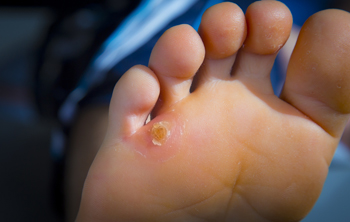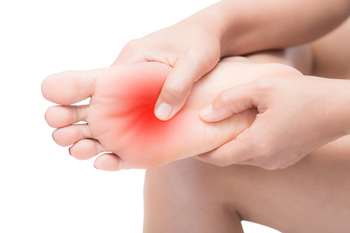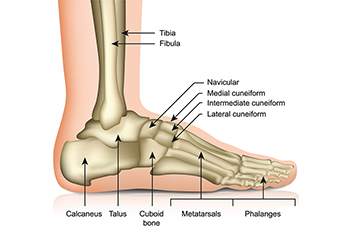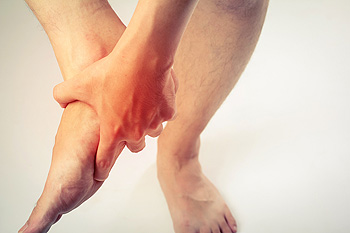December 2023

Corns are small circles of thickened skin on the feet with a hard center that can be painful, affecting your comfort with each step you take. Corns commonly develop on the top or side of the toes, and sometimes on the sole of the foot. Wearing ill-fitting shoes takes the lead in causing corns. Footwear that is too loose permits your foot to slide and rub. Meanwhile, high-heeled shoes exert undue pressure on specific foot areas, which can foster corn development. These issues intensify on bony feet that lack natural cushioning, making them more susceptible to corns. Further, corns may indicate an underlying foot problem, such as bunions or hammer toes. Addressing these root issues is important for effective corn treatment, as the thickened skin will not improve until the source of pressure is eliminated. View corns as symptoms, rather than isolated problems. Self-treatment is only advisable when the cause is understood and discussed with a chiropodist. Simple solutions like corn plasters are available, but caution is needed. Individuals with diabetes, circulation problems, or fragile skin should consult a chiropodist for tailored treatment options. Treating corns means more than managing symptoms. It is also about addressing underlying causes for lasting relief. If you are uncertain about the best course of action in managing painful corns on the feet, it is suggested that you schedule an appointment with a chiropodist.
Corns are small bumps or dry, hardened skin that can arise on the feet, usually in response to friction. Corns can be asymptomatic, or they can be uncomfortable or painful. If you have corns that are bothering you, please consult with one of the chiropodists from The Footcare Centre. Our chiropodists can help you maintain the health of your lower limbs and your mobility.
There are three types of corns:
Hard corns
Often occur on the tops of toes
Feature a hard core surrounded by dry, irritated skin
Can be painful
Soft corns
Often occur in between the toes
Soft due to constant exposure to sweat
Can be painful
Seed corns
Tiny
Often occur on the soles of the feet
Usually asymptomatic
Corns can be prevented by wearing shoes that fit properly. They are typically benign and don’t require medical treatment. However, if your corns are causing you pain or discomfort, don’t hesitate to reach out to a chiropodist near you for treatment options. If you have any questions, please feel free to contact our office located in . We offer the newest diagnostic and treatment technologies for all your foot care needs.

Common peroneal nerve dysfunction, also known as common fibular nerve dysfunction, results from damage to the peroneal nerve. This condition causes loss of movement and sensation in the foot and leg. The peroneal nerve, a branch of the sciatic nerve, is responsible for lower leg, foot, and toe function. Causes of dysfunction include fibula fractures, long-term leg constriction, habitual leg crossing, or pressure during deep sleep. It is more common in individuals with anorexia nervosa, autoimmune diseases, diabetes, and alcohol misuse. Symptoms include a decreased sensation or tingling in the leg, foot drop, toe dragging, and walking difficulties. Diagnosis involves physical exams, electromyography, nerve conduction tests, an MRI, and a nerve ultrasound. Recovery depends on the severity of nerve damage, and severe cases may lead to permanent disability. If you suffer nerve damage symptoms as described above, it is strongly suggested that you make an appointment with a chiropodist as quickly as possible which may help to prevent further complications.
Neuropathy can cause permanent nerve damage if left untreated. If you are experiencing the symptoms of peripheral neuropathy, please consult with one of the chiropodists from The Footcare Centre. Our chiropodists will assess your condition and provide you with quality foot and ankle treatment.
What Is Peripheral Neuropathy?
Peripheral neuropathy is a condition that damages the nerves of the peripheral nervous system, which provide sensation to the limbs. The feet are often affected. Peripheral neuropathy can have many different causes, but it is most commonly associated with diabetes.
Symptoms
Common symptoms of peripheral neuropathy include:
Pain
Numbness or tingling sensation
Burning sensations
Weakness
Loss of balance
Diagnosis
Peripheral neuropathy is diagnosed based on medical history and physical examination. Various tests performed during physical examinations can help determine the type of peripheral neuropathy you may have and what is causing it.
Treatment
Treatment for peripheral neuropathy will depend on what is causing it. For example, if your peripheral neuropathy is caused by diabetes, then managing your blood sugar, exercising regularly to strengthen the legs and feet, and taking pain medications may be recommended as treatments.
If you have any questions, please feel free to contact our office located in . We offer the newest diagnostic and treatment technologies for all your foot care needs.

Foot pain, a nuanced tapestry of discomfort, can emanate from various structures within the foot, leading to a spectrum of problems. The plantar fascia, a band of tissue supporting the arch, may ignite pain when strained, giving rise to conditions like plantar fasciitis. Achy joints and inflammation often signal arthritis, affecting the foot's intricate network of bones and ligaments. Nerve entrapment, as seen in conditions like Morton's neuroma, generates sharp, localized pain. Bunions, a result of misalignment in the joint at the base of the big toe, cause persistent pain and deformity. Toe deformities such as hammertoes, can contribute to discomfort due to irregular pressure on joints. Stress fractures are microcracks in bones and are often triggered by repetitive impact, which can manifest as localized pain during activity. Understanding the structures involved in foot pain equips individuals to identify and address specific foot problems promptly. If you have foot pain, and would like to know more about the anatomy of the foot, it is suggested that you schedule an appointment with a chiropodist.
The biomechanics of your feet play an important role in your foot health. To learn more, please consult with one of the chiropodists from The Footcare Centre. Our chiropodists can help you maintain the health of your lower limbs and your mobility.
Foot biomechanics refers to the study of the structure, function, and motion of the feet. The feet and ankles are a complex system consisting of many bones, joints, ligaments, muscles, and tendons that work together to move your feet. Understanding the unique biomechanics of your own feet can help you and your chiropodist make informed decisions about your foot health care. This includes decisions about the best preventive measures to avoid foot pain, the best treatment options for various foot problems, and finding the best shoes for your feet.
If you have any questions, please feel free to contact our office located in . We offer the newest diagnostic and treatment technologies for all your foot care needs.

Plantar fasciitis is a condition that occurs when the fibrous attachment that connects the toes to the heel becomes irritated and inflamed. This band of tissue is medically known as the plantar fascia and is essential in supporting the foot's arch and biomechanics during activities, such as walking and running. Excessive tension and stress can lead to damage and inflammation of the plantar fascia. The primary cause of plantar fasciitis is overuse, resulting from daily activities or intense physical exertion. This overuse can lead to inflammation, which causes swelling, tenderness, and pain primarily in one foot, though both feet can be affected simultaneously. Contributing factors to plantar fasciitis can include a sudden increase in physical activity, prolonged standing on hard surfaces, and walking barefoot. In addition, inadequate foot support from ill-fitting shoes, certain medical conditions, and rheumatoid arthritis may result in plantar fasciitis. Further, obesity, flat or high-arched feet, and lack of warmups before exercise may be factors. Regular use of high-heeled shoes, and wearing worn-out footwear are also known causes. Certain risk factors increase the likelihood of developing plantar fasciitis. Overweight individuals experiencing heightened pressure on the plantar fascia ligaments are more susceptible. Wearing unsupportive footwear, such as high heels, further elevates the risk. To reduce or eliminate the pain of plantar fasciitis, it is suggested that you schedule an appointment with a chiropodist who can offer treatment options.
Plantar fasciitis can be painful and interfere with your daily activities. If you are experiencing foot or heel pain and believe you may be afflicted with plantar fasciitis, please consult with one of the chiropodists from The Footcare Centre. Our chiropodists will assess your condition and provide you with quality foot and ankle treatment.
What Is Plantar Fasciitis?
Plantar fasciitis refers to the inflammation of the plantar fascia, a ligament that runs along the bottom of the foot and connects the heel bone to the toes. Repetitive activities, such as running or jumping, can injure the plantar fascia over time. Plantar fasciitis can also be caused by flat feet, high arches, pregnancy, and activities that put excessive pressure on your feet, like standing all day for work. When the plantar fascia becomes inflamed, it causes pain and discomfort.
Symptoms
Typical symptoms of plantar fasciitis include:
Stabbing pain near the heel
Pain that is worst in the morning or after a period of rest
Pain that increases after exercising
Swelling
Tightness in the Achilles tendon
Diagnosis
Plantar fasciitis is typically diagnosed via medical history and physical examination.
Treatment
Treatments for plantar fasciitis include resting and icing the affected foot, stretching the foot, taking medications to reduce inflammation, and wearing orthotics. In severe cases where pain does not improve with conservative treatments, injections or surgery may be recommended.
If you have any questions, please feel free to contact our office located in . We offer the newest diagnostic and treatment technologies for all your foot care needs.
Blog Archives
- 2025
- 2024
- 2023
- 2022
- 2021
- 2020


